
Station Name: HOPPERTON
|
| Date opened: | 30.10.1848 |
| Location: | On the open Harrogate to York line at 12m16ch; immediately west of A1(M) bridge. |
| Company on opening: | East & West Yorkshire Junction Railway |
| Date closed to passengers: | 15.9.1958 |
| Date closed completely: | 5.11.1962 |
| Company on closing: | British Railways (North Eastern Region) |
| Present state: | Station building is in residential use, York-bound platform under A168 and A1M, retaining wall of Harrogate-bound platform remains. Cattle dock, base of 5-ton crane, remains of coal depot and coal weighing shed remain. |
| County: | Yorkshire West Riding (now North Yorkshire) |
| OS Grid Ref: | SE414562 |
| Date of visit: | June 1973, April 2016 |
Notes: Allerton station – later renamed Hopperton - stood on the Harrogate-York line. The western end of this route originated on 21 July 1845 when the Leeds & Thirsk Railway (L&T) was authorised to construct a branch line from its planned main line at Starbeck (where it skirted the eastern fringe of Harrogate) to Knaresborough. The East & West Yorkshire Junction Railway (EWYJ) – described by Hoole (1974) as a protégé of George Hudson’s York & North Midland Railway (YNM) – was authorised on 16 July 1846 to build from York to Knaresborough. The L&T seemed to be showing excessive interest in the EWYJ in 1847, but Hudson’s influence won the day. When the line opened on 30 October 1848 from Skelton Junction - where the new route diverged from the Hudson’s York, Newcastle & Berwick Railway - the latter company provided the motive power. The western terminus of the new line was at Hay Park Lane, in the countryside about a mile east of Knaresborough, where a wooden shed was provided to give some shelter to passengers. This temporary measure was necessary because the L&T’s viaduct over the River Nidd, immediately west of Knaresborough station, collapsed on 11 March 1848 as it approached completion. The successfully completed structure was notable for its castellated piers intended to complement the ruins of the nearby castle.
Note: HPL – Hay Park Lane (or Hay-a-Park Lane)temporary terminus; the published timetable simply calls the western destination ‘Knaresborough’.
From 1851 the EWYJ operated its own motive power with the assistance of E B Wilson & Co, locomotive builders of Leeds. On 28 May 1852 the EWYJ was absorbed into the YNM company; the L&T had been renamed the Leeds Northern Railway (LN) on 3 July 1851; and both the YNM and LN companies became part of the newly-formed North Eastern Railway in 1854. The present Harrogate station opened on 1 August 1862; it became the western terminus of the line from York and replaced the Brunswick terminus, as mentioned above. Allerton station was built on land purchased from the Right Honourable Lord Stourton 1846. Allerton Park, about a mile north of the station, was acquired by the wealthy Stourton family in the early nineteenth century, and this probably explains not only the choice of name for the station but also why a station was provided at all and given an unexpectedly substantial building in a sparsely populated area. The original intention of the EWYJ was to provide only three large wayside stations at Poppleton, Cattal and Marston (later Marston Moor), but the decision was made to build one at Allerton too; all four possessed a distinctive design of station, credited to the line’s Engineer, Thomas Grainger of Edinburgh, and they all survive at the time of writing (summer 2016). Passenger trains also called at Hessay, Hammerton and Goldsborough level crossings - possibly from the day that the line opened in October 1848, but definitely within two years of this date - and formal stations were soon provided; the buildings at these stations were more modest than at Allerton, being enlargements of the original gatekeepers’ cottages. Before it was diverted a short distance eastwards, for many years the main London–Edinburgh road (A1) crossed the railway at Allerton. Standing on the northern (up) side of the railway, several yards west of the level crossing, the lofty, red-brick gabled house is flanked by lower two-storey wings. A stone canted bay window (originally the main waiting room) is on the ground floor of the house. The space in the centre of the broad main gable above the upper storey window has a hooded circular recess which was probably intended to accommodate a clock, although none was ever fitted. The remains of an outdoor clock next to the bay window are the only evidence of external timekeeping. Stone quoins and architraves lend dignity to the building. A glazed verandah with end-screens sheltered the platform for the full length of the building; it is not known when the verandah was removed. Remains of a brick structure, referred to as ‘offices’ on plans, are east of the main building, next to the level crossing. An internal plan of 1857 showed the accommodation to be split between the commercial/public area and the rooms occupied by the stationmaster. The station included a booking office, luggage room, lamp room, general waiting room, ladies’ waiting room, public WC, coal house, weigh office, sack room and lime shed. The stationmaster’s accommodation included an entrance, living room, pantry and two bedrooms. The NER added a timber waiting room east of the main building.
In the timetable, below, for February 1863 the Harrogate terminus is the present-day station which had opened in 1862.
Notes: ‡ Approximate time; calls by request *Timetable heading refers to the station as ‘High Harrogate’ – presumably owing to inertia, as High Harrogate had been named Starbeck since 1857. The 1863 timetable shows that there were five (one by request) Monday-to-Friday York-bound trains and four towards Harrogate. In July 1872 there was an extra evening service toward Harrogate bringing the total to five each way. Between York and Knaresborough the railway passed through lightly populated countryside with a scattering of villages and isolated farms, and the frequency of train calls at Allerton was similar to the other rural stations on the line in the late nineteenth century - with the exception of Wilstrop Siding which had only a Saturday service of one train stopping in each direction. The 1896 table, below, shows the situation shortly before road motor transport began to offer competition to the trains. The Wednesday-only arrival at 3.31pm is for passengers to alight having visited Knaresborough market.
Note: *Market Train
The principal goods traffic handled at Allerton in 1913 consisted of 421 tons of barley and 367 tons of potatoes, and 41 wagons of livestock were dispatched; as at most stations, coal was also received by rail. The table below for June 1920 shows the service 2½ years before the NER was absorbed into the London & North Eastern Railway at the ‘Grouping’. At this time the station was still known as Allerton.
In January 1923 the NER became part of the London & North Eastern Railway (LNER) at the ‘Grouping’. At this time C Atkinson was stationmaster, having been promoted to the post from collecting tickets at York. He remained at Allerton until November 1923 when a further promotion transferred him to the busier station of Poppleton. The LNER considered that the lightly-used Allerton station should be supervised by the stationmaster of neighbouring, Goldsborough, and in August 1924 G Milner, the former stationmaster of Kettleness on the Yorkshire coast, assumed the new post. The NER was averse to having more than one station of the same name within its network and even avoided sharing names with stations owned by other companies. There was another Allerton station on the London & North Western in the suburbs of Liverpool, but it was not until 1925 that the LNER changed the name of their station of this name to Hopperton - from 21 September in their timetable, and officially from 1 October. Hopperton was a hamlet close to the railway, about half a mile east of the station. In September 1925 the train frequency was still at the level that the NER provided five years earlier. It is not known how long stationmaster Milner was in post at Goldsborough and Hopperton, but a new incumbent was appointed in September 1935; this was S Hill, previously a goods clerk at York. He was in post until June 1937 when he was promoted to stationmaster at Coxwold. He was replaced by W Pye, a clerk at Holbeck, who became stationmaster of Hopperton alone; he was here only until June 1938, when he was lured to the same post at Poppleton (like Mr Atkinson in 1923). Hopperton’s porter / signalman D V Guyll was promoted in his place to be stationmaster. For most of its life the York – Harrogate line had no Sunday service, however the July 1938 Bradshaw shows Sunday trains, but none called at Hopperton. The table includes late evening calls by request on Saturday, presumably enabling local people to return from visits to the cinema in York, Knaresborough or Harrogate.
Note: § Approximate time; calls by request to set down passengers The LNER May 1943 timetable shows a slight decline of six trains to York and five to Harrogate and the same in May 1945. On Sunday trains no longer ran. In June 1943 L W Kean was promoted from acting signalman on the East Coast main line at Heck to stationmaster of Hopperton. Mr E Ball took over the post in July 1947 before transferring to Hammerton as stationmaster in December 1948. On 1 January 1948 at nationalisation Hopperton was allocated to the North Eastern Region of British Railways. Investment in the station by BR was minimal. North Eastern Railway oil lanterns of the company’s distinctive style, slotted into cradles, were retained on the platforms, but a coat of tangerine paint – the BR(NE) colour - was applied to the wooden nameboards. The verandah on the up platform was removed, but it is not known if this was during BR or LNER years. The first BR(NE) timetable of May 1948 shows a decline in frequency of train calls at Hopperton:
From February 1949 G E Robson was stationmaster at Hopperton having transferred from a position in Hull. He moved in June 1951 to look after Moss and Balne stations on the East Coast main line south of Selby. The electoral register of February 1955 shows that Donald Elmer and his wife Dilys (who had moved into a cottage in the village by the February 1960 register) were living in the station house and the stationmaster in February 1960 is shown as Mr George Metcalfe, who lived there with his wife, Margaret. Owing to the decline in use of rural stations, in the early 1950s the neighbouring branch line from Harrogate to Pateley Bridge closed to passengers as did the branch from Knaresborough to Pilmoor on the East Coast main line. On the York – Harrogate route all stations that survived to nationalisation remained open, but in 1952/53 economies were effected by reducing the number of train calls at the quietest stations, making the services less attractive. Hopperton’s train service was almost annihilated, as seen in the summer 1958 timetable.
Despite this threadbare timetable there might be a flurry of activity (assuming that there were actually any passengers!) each Wednesday when two trains stopped at the station almost simultaneously. Passengers who had spent the morning at Knaresborough weekly market might to be alighting from the 12.46, having travelled to the market that morning by some other means of transport. The station’s modest train service did allow for a return trip from Hopperton to York for shopping on Monday-to-Friday, although passengers would be delivered to the city at an inconveniently early hour: perhaps they all invaded the station café in York while they waited for the shops to open? On 15 September 1958 there was a purge of wayside stations in the North Eastern Region, principally affecting the East Coast main line, but four of the least-used York-Harrogate stations also closed to passengers on that day: Hessay, Marston Moor, Hopperton and Goldsborough.
As mentioned earlier, in the later years at Hopperton station the signals were operated from an open frame at the eastern end of the low platform, adjacent to the road crossing – an arrangement that is still seen in 2016 at Hessay station on the same line. The block instruments at Hopperton are understood to have been housed in the NER timber waiting room / office next to the main building. When and why the old signal box was removed is not known. Once the crossing ceased to be used by a public road, signalling was no longer needed as movements in the sidings were controlled by flags. Several months later, on 5 November 1962 Hopperton ceased to handle goods traffic and the station closed entirely. An OS map of 1969-70 shows the former A1 road as merely an unfenced trackway south of the level crossing. Today the crossing is still in occasional use by farm vehicles and pedestrians. In March 1963 the Reshaping of British Railways (‘Beeching Report’) recommended the closure of the Harrogate-York line, which probably came as little surprise as the train service was not especially frequent and the A59 road ran close to the railway for its entire length. However, in September 1966 the Minister of Transport, Barbara Castle, rejected closure on the grounds of hardship that this would cause. There was no immediate evidence of investment in the reprieved line. The British Railways Board sold the station building at Hopperton on 31 March 1967 for £1,200. Whilst the other three stations that closed in 1958 were left more-or-less intact until the 1970s or beyond, Hopperton lost both the up and down platforms before 1969 and the low platform in front of the station building was partially demolished. However, the cattle dock remained in place. Economies were exercised by introducing single-line working on 4 June 1972 between Poppleton and Hammerton; the section between Cattal and Knaresborough, through Hopperton, was similarly downgraded on 16 December 1973 with the redundant track being recovered by 3 March 1974. Thus a single line currently operates at Hopperton controlled by electric token between Knaresborough and Cattal signal boxes.
Recently the A1 road has been diverted yet again at Hopperton, the new A1(M) passing between the original route and the road opened in 1962. Despite the hum of traffic on the nearby motorway, Hopperton station seems an obscure and isolated location. One of the curiosities of the York – Harrogate line is that in 2016 it remains a stronghold of semaphore signals and manually-operated level crossing gates. There are probably several factors at work to explain this. At present there is no problem with availability of staff for these duties. The equipment installed when track-singling was carried out in the 1970s is still serviceable, and with restoration of double track and even electrification in prospect it would make little sense to automate the crossings and train control until it is clear how and when the route will be upgraded – which surely will happen soon. Once considered expendable, the York-Harrogate route has gone from strength to strength with an hourly weekday service operating to and from Leeds and stopping at all stations; a further hourly service runs between Knaresborough, Harrogate and Leeds, and there are also frequent Sunday trains. On a number of recent journeys between Harrogate and York the author (AEY) has noted that the trains are well-used, sometimes with standing room only, even outside the rush hour. Organised holidays tours based in Harrogate but visiting York for the day provide many passengers for the line during the summer half of the year. Whatever the future holds for the York-Harrogate line, there can be no justification for reopening Hopperton station. Tickets from Michael Stewart. Route map drawn by Alan Young. BR timetable from Alan Young. BIBLIOGRAPHY:
To see other closed station on the York - Harrogate line click on the station name: Hessay, Marston Moor, Wilstrop Siding, Goldsborough & Knaresborough (Hay Park Lane) |
Hopperton Station Gallery 1: 1920s - May 1959

Photo from Freda Robinson

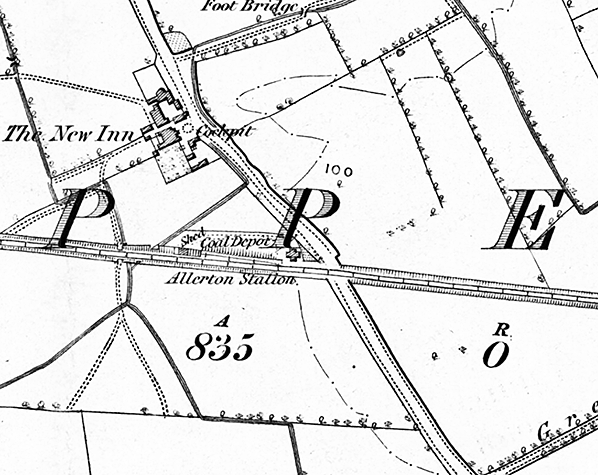
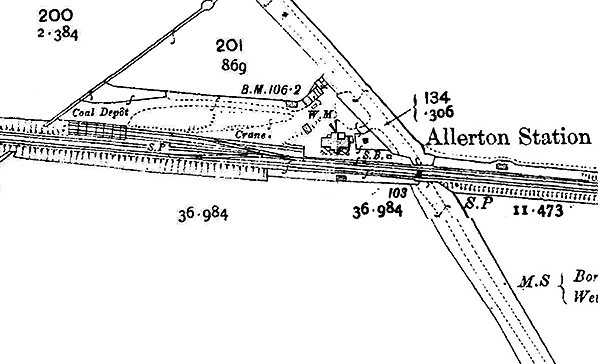
1909 1:2,500 OS map. The station is named Allerton; it would not be renamed Hopperton until 1925. The shape of the main building, west of the level crossing and north of the railway tracks, can be identified; the cross-hatching on the platform elevation represents the verandah which stretches the full length of the building. Immediately to its east, before the crossing, is a signal box. The up platform is east of the crossing and its waiting shed is shown. The down platform is west of the crossing and its waiting shed can be seen facing the main building across the tracks. The goods facilities are immediately west of the passenger station, consisting of two sidings , a headshunt and a crane; the coal depot is at the western end of the sidings, but its weigh office is some distance away, close to the road entrance to the goods yard. The New Inn is now shown as New Inn Farm.

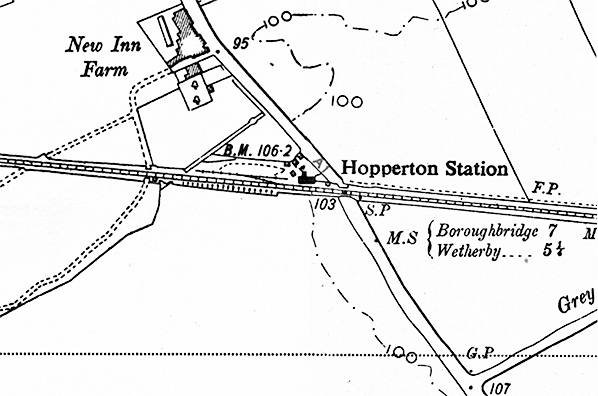
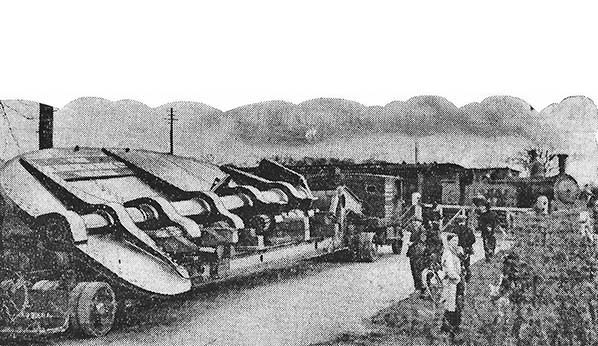
Photo from James Harwood collection

Photo from John Mann collection
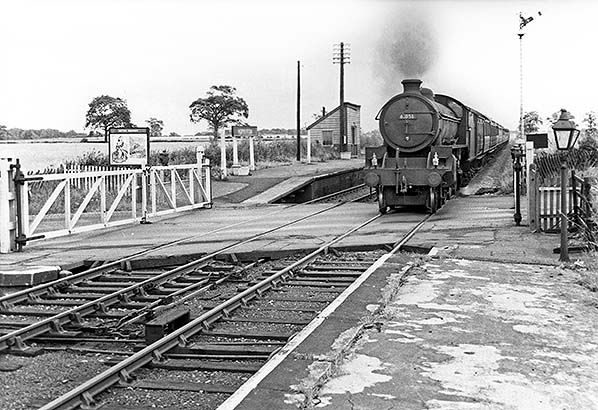
An excursion from Leicester to Harrogate in July 1959 is passing Hopperton station. The up (north) platform is seen on the left, with its distinctive pent-roof North Eastern Railway timber waiting shed and a hand-painted running-in nameboard. Although the crossing appears to be over a country lane, this is in fact the A1: the main London-Edinburgh road. The photographer is standing on the down platform ramp, the platforms being staggered either side of the crossing. The loco No.61051 is a Thompson B1 4-6-0 built in June 1946 for the LNER by the North British Locomotive Company in Glasgow. Her LNER number was 1051. She was withdrawn from 40E, Langwith shed, on 10 February 1966 and cut up in May 1966 by Arnott Young, Parkgate, Rotherham. Click here to see a similar view in 2016.
Photo by Peter Sunderland
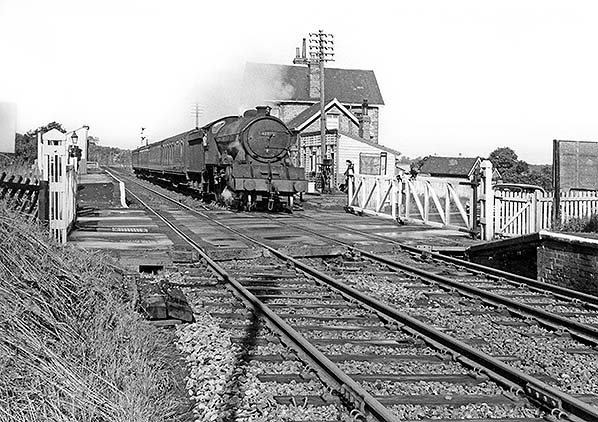
On 16 August 1958 the Saturday-only 9.00am from Harrogate to York is running non-stop through Hopperton station, almost exactly a month before the station will close to passengers; this train also runs fast through Goldsborough and Cattal, but then calls at Hammerton, Marston Moor, Hessay and Poppleton. The level crossing is over the main A1 London – Edinburgh road. The unusual layout of the station can be appreciated, with the ramp of the up platform on the extreme right, but a low platform on the same side of the track, beyond the crossing, complete with a North Eastern Railway pent-roofed timber waiting room / office structure and the main station building beyond. The open frame from which the signalling is controlled can be seen at the foot of the telegraph pole, just beyond the crossing. The down platform is ahead on the left, where an NER timber waiting shed with a steeply sloped roof can be seen. The loco is D49 ‘Hunt’ Class 4-4-0 No.62738 ‘The Zetland’, designed by Gresley and built by the LNER at Darlington in May 1932. At first the loco was numbered 220, later changed to 2738, before BR added the ‘6’ prefix. She was withdrawn from 50A, York North shed, on 21 September 1959 and cut up the following month at Darlington Works, North Road.
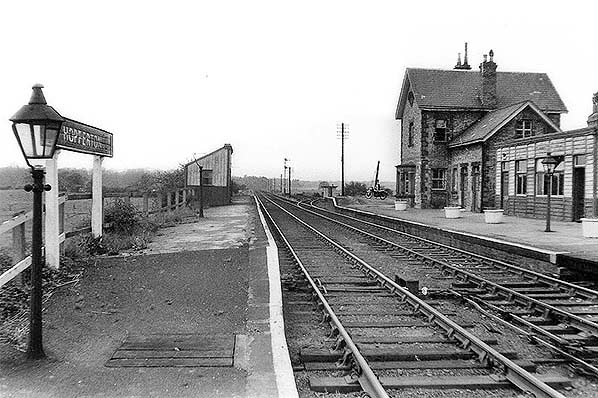
Hopperton station, looking west from the level crossing over the A1 road in May 1959. Although open for goods traffic at this time, passenger trains had ceased to call in September 1958. The down (south) platform where trains for Harrogate called is ahead, with the distinctive cradle-mounted North Eastern Railway oil lantern, and a hand-painted nameboard on LNER-style stanchions. BR (NER) generally removed nameboards soon after closure, but they were left in place at the closed York–Harrogate stations for some years, for reasons unknown. The timber waiting shed, with its steeply-sloping roof, is an NER addition. The up (York-bound) platform is behind the photographer, but a low platform on the up side is provided on the right, in front of the station building and an NER timber-built waiting shed / office. The main building is of brick, and it is one of the larger design of buildings found at the other stations which opened with the line in 1848 at Cattal, Marston Moor and Poppleton. The gable end facing the platform has a canted bay on the ground floor and a recess for a clock (never fitted) above the upper-floor window. The low platform rises at the far end to form the cattle dock, on which the motor cycle is parked. Beyond this, the goods sidings, yard crane and a platelayers’ hut can be seen.
Copyright photo from Martin Bairstow and John Mann collections
Click here for Hopperton Station Gallery 2:
July 1959 - April 2016

|
| Last updated: Sunday, 21-May-2017 11:17:17 CEST |
© 1998-2016 Disused Stations
|
 As indicated in Reid’s Monthly Railway Time Table for May 1849 (above) trains travelled only as far west as Knaresborough – or, more correctly, to the temporary terminus about a mile short of Knaresborough. On 21 July 1851 the Leeds Northern Railway (renamed from L&T on 3 July) branch from Starbeck opened to meet the line from York in Knaresborough, and the temporary Hay Park Lane station was closed and dismantled. What is now Starbeck station was identified in Bradshaw by various names – including Harrogate, Harrogate & Knaresborough, High Harrogate and Harrogate High – until it settled down to be Starbeck in 1857. Trains on the Leeds and Wetherby lines used another Harrogate station (the terminus usually suffixed ‘Brunswick’ in modern literature to distinguish it from the present station which replaced it in 1862). On 1 August 1862, when the present Harrogate station opened, it became the western terminus of the line from York.
As indicated in Reid’s Monthly Railway Time Table for May 1849 (above) trains travelled only as far west as Knaresborough – or, more correctly, to the temporary terminus about a mile short of Knaresborough. On 21 July 1851 the Leeds Northern Railway (renamed from L&T on 3 July) branch from Starbeck opened to meet the line from York in Knaresborough, and the temporary Hay Park Lane station was closed and dismantled. What is now Starbeck station was identified in Bradshaw by various names – including Harrogate, Harrogate & Knaresborough, High Harrogate and Harrogate High – until it settled down to be Starbeck in 1857. Trains on the Leeds and Wetherby lines used another Harrogate station (the terminus usually suffixed ‘Brunswick’ in modern literature to distinguish it from the present station which replaced it in 1862). On 1 August 1862, when the present Harrogate station opened, it became the western terminus of the line from York. 
 The census of 1911 revealed that a population of only 457 was served by Allerton station and NER statistics show that 5,901 tickets were issued that year; at nearby Cattal the total was 15,169 while Knaresborough sold 191,752 tickets. Further census information from 1911 indicates that the stationmaster at Allerton was a Mr Memmell and that the house was occupied by 3 males and 3 females. Confusingly the NER stationmasters database gives conflicting and internally inconsistent information about this man, spelling his name Mennell and stating that he took up his post here in March 1915. Creative interpretation of the data might suggest that he was appointed to Allerton in 1905, moved on to Hampsthwaite in 1912 and died in February 1915.
The census of 1911 revealed that a population of only 457 was served by Allerton station and NER statistics show that 5,901 tickets were issued that year; at nearby Cattal the total was 15,169 while Knaresborough sold 191,752 tickets. Further census information from 1911 indicates that the stationmaster at Allerton was a Mr Memmell and that the house was occupied by 3 males and 3 females. Confusingly the NER stationmasters database gives conflicting and internally inconsistent information about this man, spelling his name Mennell and stating that he took up his post here in March 1915. Creative interpretation of the data might suggest that he was appointed to Allerton in 1905, moved on to Hampsthwaite in 1912 and died in February 1915.
 A horrific accident occurred at Hopperton on 26 April 1988 when an articulated lorry, loaded with steel, jack-knifed on the A1 bridge immediately east of the station as it was braking in heavy rain when approaching a contraflow. The vehicle demolished the parapet and the driver was thrown
A horrific accident occurred at Hopperton on 26 April 1988 when an articulated lorry, loaded with steel, jack-knifed on the A1 bridge immediately east of the station as it was braking in heavy rain when approaching a contraflow. The vehicle demolished the parapet and the driver was thrown  Home Page
Home Page